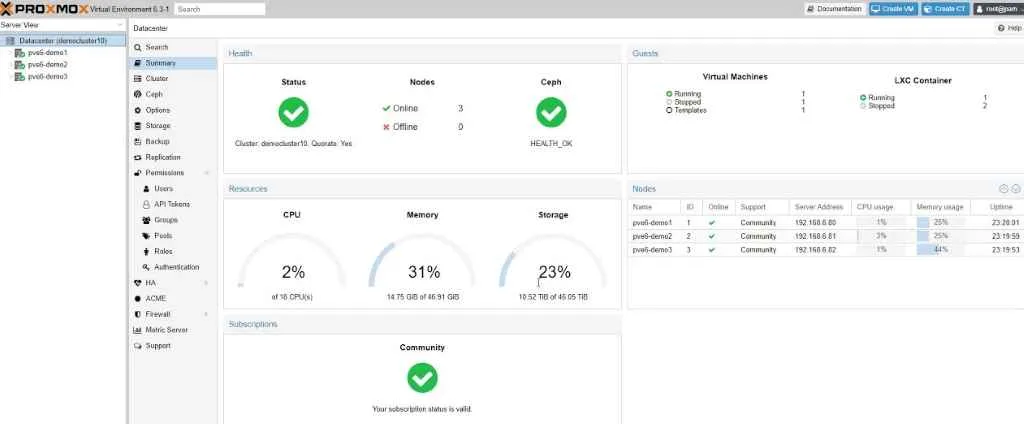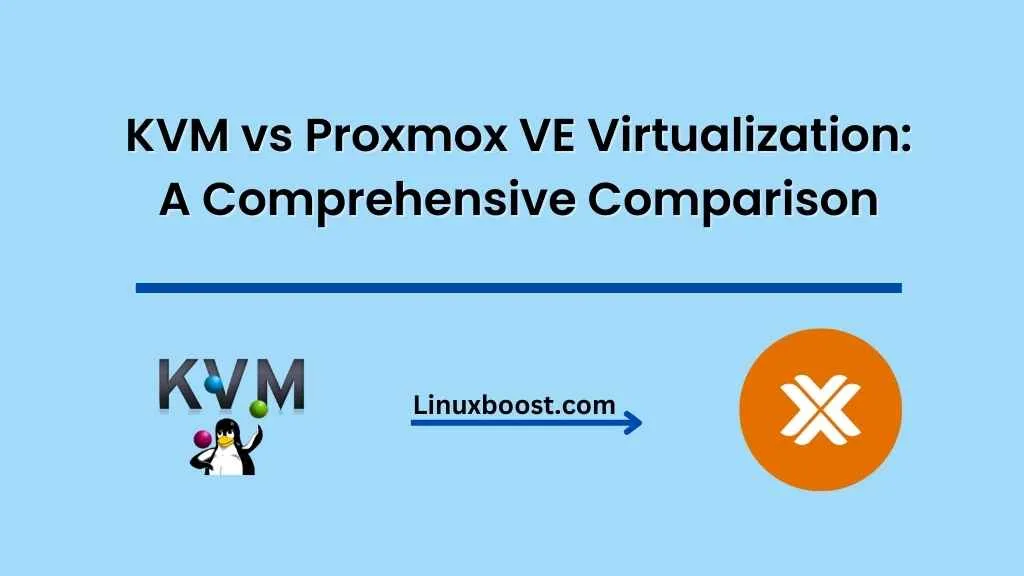Virtualization has revolutionized the way we manage and deploy computing resources, enabling organizations to optimize hardware utilization, increase flexibility, and reduce costs. In this blog post, we will compare two popular virtualization technologies: KVM vs Proxmox VE Virtualization We’ll discuss their key features, performance, ease of use, and community support to help you decide which solution is right for your needs.
KVM vs Proxmox VE Virtualization
1. Overview
KVM (Kernel-based Virtual Machine) is a native Linux virtualization technology that turns the Linux kernel into a bare-metal hypervisor, providing high performance and strong isolation between virtual machines. It supports a wide range of guest operating systems and is widely used in various environments, from personal use to enterprise-grade deployments.
Proxmox VE (Virtual Environment) is an open-source platform built on top of KVM and LXC (Linux Containers) technologies. It provides a user-friendly web-based interface for managing virtual machines and containers, along with advanced features like clustering, high availability, and live migration. It is also suitable for both personal use and enterprise deployments.
2. Features and Capabilities
KVM
- Supports multiple guest operating systems, including Linux, Windows, and macOS
- Integrates with libvirt, providing a standard API for managing VMs
- Can be managed using various tools, such as
virsh,virt-manager, and Ansible - Offers live migration and snapshots
- Extensible with third-party tools and plugins
Proxmox VE
- Provides a user-friendly web-based interface for managing VMs and containers
- Supports clustering and high availability
- Offers live migration, snapshots, and backups
- Includes built-in networking and storage management features
- Integrates with various third-party tools, such as Ceph, ZFS, and GlusterFS
3. Performance
Both KVM and Proxmox VE offer high-performance virtualization, thanks to their use of hardware-assisted virtualization technologies like Intel VT-x and AMD-V. However, Proxmox VE may have a slight performance overhead due to its additional management features and web interface. In most cases, this overhead is negligible and should not impact overall performance.

4. Ease of Use
KVM is a powerful and flexible virtualization solution but may require more manual configuration and command-line usage, especially when compared to Proxmox VE. On the other hand, Proxmox VE’s web-based interface makes it easier to manage VMs and containers, even for users with limited experience in virtualization.
Additionally, Proxmox VE includes built-in networking and storage management features, simplifying the overall setup process. For example, it provides an easy-to-use interface for managing RAID configurations and LVM volumes, while KVM requires additional tools and manual configuration.
5. Community Support
Both KVM and Proxmox VE have active and vibrant communities that offer excellent support and resources, such as documentation, forums, mailing lists, and more. The KVM community is larger due to its status as a native Linux technology, but Proxmox VE’s community is growing rapidly as well.
Moreover, both technologies are backed by strong commercial entities: KVM is supported by Red Hat.
Proxmox VE is developed and maintained by Proxmox Server Solutions GmbH. This ensures that both solutions receive regular updates, improvements, and professional support options.
6. Integration with Other Tools and Ecosystems
KVM’s integration with libvirt and its support for various management tools and APIs make it a versatile solution that can easily fit into different ecosystems. For instance, you can use KVM with OpenStack for cloud deployments or with oVirt for data center virtualization. Additionally, popular configuration management tools like Ansible and Terraform easily manage KVM.
Proxmox VE, on the other hand, provides its own management ecosystem, including a web interface and a REST API. It also integrates with popular storage and networking solutions, such as Ceph, ZFS, and Open vSwitch, making it a comprehensive virtualization platform. However, its tight integration with these technologies might make it less flexible than KVM when it comes to integrating with other tools and ecosystems.
7. Licensing and Cost
Both KVM and Proxmox VE are open-source solutions, which means they are free to use and distribute. However, Proxmox VE offers a subscription-based support model that includes access to stable software updates, technical support, and other benefits. While subscribing to Proxmox VE support is not mandatory, it is recommended for production environments to ensure a stable and secure experience.
KVM, being a part of the Linux kernel, is completely free and does not require any additional subscriptions. However, You can obtain professional support for KVM through vendors like Red Hat or Canonical, as they offer commercial support for their respective Linux distributions.
Conclusion
Both KVM and Proxmox VE are powerful and feature-rich virtualization solutions that can cater to various use cases and requirements. KVM offers more flexibility and a larger ecosystem, making it an excellent choice for users who require a versatile solution that can integrate with various tools and platforms.
Proxmox VE’s user-friendly interface and built-in management features make it an attractive option for users who value ease of use and a comprehensive management solution.
Ultimately, the choice between KVM and Proxmox VE will depend on your specific needs, preferences, and technical expertise.





